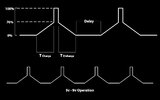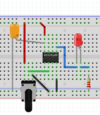EdStraker
Member
I have constructed a variety of "strobe" circuits in the past using Transistors and 555's but never both. Since I've been on a circuit binge lately I thought I might as well post this problem too.
Concept is a modified Sine Wave to have a low glow LED slowly ramp up to 50%-70% brightness and then "spike" or "flash" at peak brightness then ramp back down to minimum glow again. But, have adjustable timing and 50-50 adj ramp time also. I have attached a graphical interpretation of what I am trying to achieve.
*Correction on schematic 0% should have been 10%
Concept is a modified Sine Wave to have a low glow LED slowly ramp up to 50%-70% brightness and then "spike" or "flash" at peak brightness then ramp back down to minimum glow again. But, have adjustable timing and 50-50 adj ramp time also. I have attached a graphical interpretation of what I am trying to achieve.
*Correction on schematic 0% should have been 10%
Attachments
Last edited:




